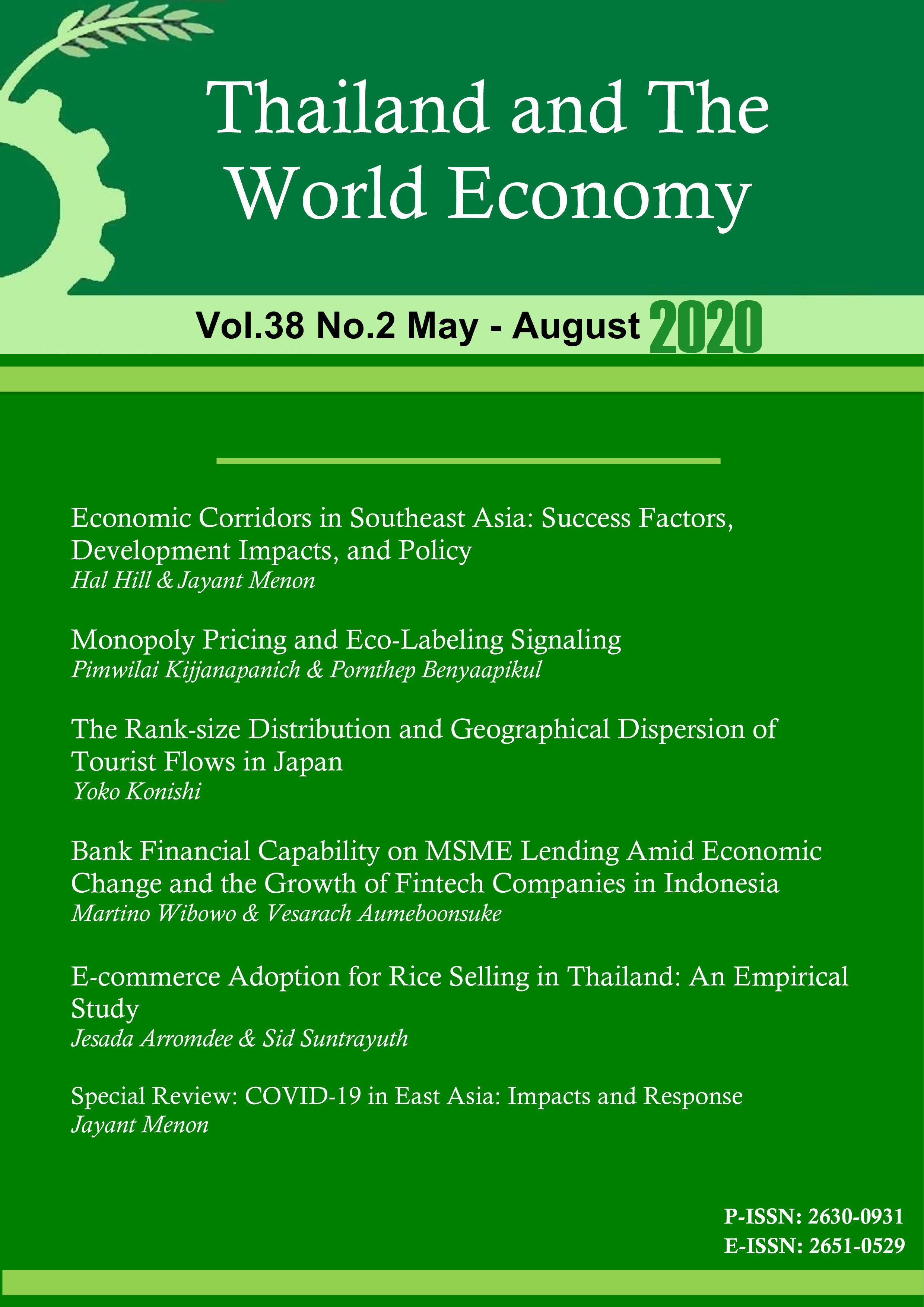Rank-size Distribution and the Geographical Dispersion of Tourist Flows in Japan
Keywords:
Inbound tourism boom, Zipf’s law, Gibrat’s Law, Rank-clocks, Geographical DispersionAbstract
Since 2012, the importance of the tourism industry in Japan has been increasing due to an unprecedented inbound tourism boom. This paper examines the rank-size distribution, geographical dispersion and growth rates and study whether Zipf’s and Gibrat’s laws strike Japan’s tourist flows. For inbound tourists to Japan, this is the first study analyzed by country of origin. Our analysis reveals that both the ranks and the sizes for Japanese tourists are stable, while the numbers of inbound tourists of origin countries have higher growth rates and fluctuate in rank order. Based on our comparative analysis, we conclude that the Southeast Asian countries will continue to grow, and there is room for improving geographical dispersion. They will have high potential about increasing share of the inbound market.
References
Batty, M. (2006). Rank clocks. Nature, 444(7119), 592-596.
Batty, M. (2008). The Size, Scale, and Shape of Cities. Science, 319(5864), 769-771.
Blackwell, C., Pan, B., Li, X., & Smith, W. (2011). Power laws in tourist flows. Proceeding of the Travel and Tourism Research Association 42nd Annual Conference, TTRA Association.
Berliant, M., & H. Watanabe (2007). Explaining the size distribution of cities: X-treme economies. MPRA Paper No.5428, University Library of Munich, Germany.
Bowden, J. (2003). A cross-national analysis of international tourist flows in China. Tourism Geographies, 5(3), 257–279.
Brakman, S., H. Garretsen, C. Van Marrewijk, & M. van den Berg (1999). The return of Zipf: A further understanding of the rank-size distribution. Journal of Regional Science, 39, 183-213.
Córdoba, J.C. (2008). On the distribution of city sizes. Journal of Urban Economics, 63(1), 177-197.
Davis, R. D., & Weinstein, D. E. (2002). Bones, bombs, and break points: The geography of economic activity. The American Economic Review, 92(5), 1269-1289.
Duranton, G. (2007). Urban evolutions: the fast, the slow, and the still. The American Economic Review, 97(1), 197-221.
Eeckhout, J. (2004). Gibrat’s law for (all) cities. The American Economic Review, 94, 1429-1450.
Gabaix, X. (1999). Zipf’s law for cities: An explanation. The Quarterly Journal of Economics, 114(3), 739-767.
Gabaix, X., & Ibragimov, R. (2011). Rank - 1 / 2: A simple way to improve the OLS estimation of tail exponents. Journal of Business & Economic Statistics, 29(1), 24-39.
Guo, Y., Zhang, J., & Zhang, H. (2016). Rank-size distribution and Spatio-temporal dynamics of tourist flows to China’s cities. Tourism Economics, 23(3), 451-465.
Ioannides, Y., & Overman, H. (2003). Zipf's law for cities: an empirical examination. Regional Science & Urban Economics, 33(2), 127-137.
Lau, P. L., Koo, T. T. R., & Wu, C. L. (2020). Spatial distribution of tourism activities: A polya urn process model of rank-size distribution. Journal of Travel Research, 59(2), 231-246.
Konishi, Y. (2019). The role of global value-chain in services: Through recent inbound tourism in Japan. Journal of Southeast Asian Economies, 36(2), 183-203.
Konishi, Y., & Nishiyama, Y. (2019). Comparison of inbound and domestic tourists destinations in Japan from 2011 to 2017: Zipf's law and Gibrat's law. RIETI Discussion Paper, 19-J-008 (in Japanese).
Koo, T. T. R., Lau, P. L., & Dwyer, L. (2017). The geographic dispersal of visitors: Insights from the power law. Journal of Travel Research, 56(1), 108-121.
Mori, T. (2017) Evolution of the size and industrial structure of cities in Japan between 1980 and 2010: Constant Churning and Persistent Regularity. Asian Development Review, 34(2), 86–113.
Provenzano, D. (2014). Power laws and the market structure of tourism industry. Empirical Economics, 47(3), 1055–1066.
Reed, W. (2001) The Pareto, Zipf and other power law. Economics Letters, 74, 15-19.
Rosen, K. T., & Resnick, M. (1980). The size distribution of cities: an examination
of the Pareto law and primacy. Journal of Urban Economics, 8(2), 156-186.
Soo, K. T. (2005). Zipf's law for cities: a cross-country investigation. Regional
Science & Urban Economics, 35(3), 239-263.
Ulubaşoğlu, M. A., & Hazari, B. R. (2004). Zipf’s law strikes again: The case of tourism. Journal of Economic Geography, 4(4), 459-472.
Wen, J. J., & Sinha, C. (2009). The spatial distribution of tourism in China: Trends and impacts. Asia Pacific Journal of Tourism Research, 14(1), 93-104.
Yang, X. Z., & Wang, Q. (2014). Exploratory space-time analysis of inbound tourism flows to China cities. International Journal of Tourism Research, 16(3), 303–312.
Yang, Y., & Wong, K. K. F. (2013). Spatial distribution of tourist flows to China’s cities. Tourism Geographies, 15(2), 338–363.
Zhang, Y., Xu, J. H., & Zhuang, P.J. (2011). The spatial relationship of tourist distribution in Chinese cities. Tourism Geographies, 13(1), 75–90.
Zipf, G.K. (1949). Human behavior and the principle of least effort, Cambridge, MA: Addison-Wesley Press.










